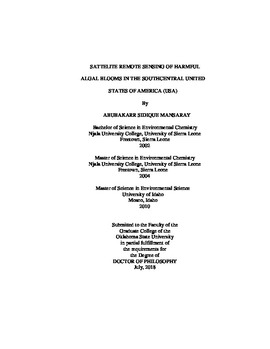| dc.contributor.advisor | Stoodley, Scott Howard | |
| dc.contributor.author | Mansaray, Abubakarr Sidique | |
| dc.date.accessioned | 2019-05-08T19:52:50Z | |
| dc.date.available | 2019-05-08T19:52:50Z | |
| dc.date.issued | 2018-07 | |
| dc.identifier.uri | https://hdl.handle.net/11244/319639 | |
| dc.description.abstract | The goal of water quality monitoring is to detect pollutants such as harmful algal blooms (HABs) and guide management decisions. A major challenge to this is the uncertainty in detecting pollutants in space and time. In Grand Lake O' The Cherokees, HABs became a public health concern in July 2011 when an advisory for no body contact included the Fourth of July holiday. This created the need to develop new strategies for timely detection of HABs. Satellite remote sensing provided the opportunity to achieve this goal. The Grand River Dam Authority (GRDA) funded this research, which integrated in situ water quality data, Landsat 8 data, and machine learning to build a tool for automated detection of HABs in the Grand Lake Watershed. We collected in situ samples from four reservoirs in the watershed and developed indices for algae and turbidity for input in the HABs monitoring tool. The tool utilizes Python programming language and extracts Landsat data from the United States Geological Survey (USGS) website for an interpretation protocol (High, Medium, and Low). This research also studied lake water quality by ecoregion and hydrologic unit Levels 4 and 6 in Oklahoma to guide ground-based sampling. The goal is to utilize this information for regional application of the HABs monitoring tool. Further studies will delineate the spatial extent of sample points within a pixel, fusion of different satellite platforms, empirical data to calibrate and validate the monitoring tool, and the social/economic benefits of this new HABs detection strategy. | |
| dc.format | application/pdf | |
| dc.language | en_US | |
| dc.rights | Copyright is held by the author who has granted the Oklahoma State University Library the non-exclusive right to share this material in its institutional repository. Contact Digital Library Services at lib-dls@okstate.edu or 405-744-9161 for the permission policy on the use, reproduction or distribution of this material. | |
| dc.title | Satellite remote sensing of harmful algal blooms in the southcentral United States of America (USA) | |
| dc.contributor.committeeMember | Dzialowski, Andrew R. | |
| dc.contributor.committeeMember | Wagner, Kevin Lee | |
| dc.contributor.committeeMember | Torbick, Nathan M. | |
| osu.filename | MANSARAY_okstate_0664D_15910.pdf | |
| osu.accesstype | Open Access | |
| dc.type.genre | Dissertation | |
| dc.type.material | Text | |
| thesis.degree.discipline | Environmental Science | |
| thesis.degree.grantor | Oklahoma State University | |
